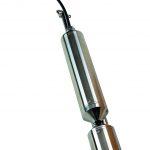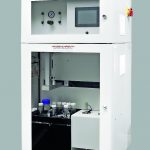It is advisable to use the type of analyser best suited for the application at hand. Instrument selection should consider the detection and oxidation methods as well as the accuracy, reliability and costs. The German companies Gimat Liquid Monitoring and Dimatec Analysentechnik offer fitting measurement solutions for numerous applications.
The determination of all organic substances in water is a far from trivial task. The different organic compounds are simply too numerous for individual analysis. Instead, sum parameters are used. One of these parameters is steadily increasing in importance: TOC (total organic carbon). Online instruments reduce the workload of the personnel on site and provide continuous or discontinuous monitoring of process, drinking or waste water. A broad array of types are already available. Various methods are employed, ranging from probe systems to more complex analysers.
Spectrometric probes
Compact spectrometric probes are available for TOC determination. These probes are directly immersed in the medium (in situ) or used in a flow cell. The measuring principle of these instruments exploits a physical property exhibited by many organic compounds, namely the absorption of light at certain wavelengths. The measurement is conducted either at 254 nm, e. g. by Gimat’s Spectro-Cont, or over a whole range in the UV/Vis spectrum. The method is also known as SAC (spectral absorption coefficient) when only the 254 nm wavelength is used.
This measurement method allows cost-efficient monitoring in real time, requires no reagents and is virtually maintenance-free. The spectrometric measurement becomes a TOC measurement after conversion from SAC or UV/Vis data. One drawback of such optical methods results from the absorption properties, which are completely different for many compounds. An appropriate, matrix-specific conversion factor is consequently required for each application. Every change to the matrix can also change the conversion factor. Some of the instruments measuring across a range of wavelengths can adjust this conversion factor automatically based on a database of historical values. However, a knowledge of the application and of the expected fluctuations in the composition are a requirement for this process. Owing to this disadvantage of probe systems, analysers are recommended for operation with sample matrices of varying composition.
Analysers
The carbon content to be measured in the sample first of all has to be converted to CO2 by oxidation using TOC analysers. There are two main techniques which are then applied to detect the generated CO2: conductivity measurement and infrared.
Conductivity detectors determine CO2 indirectly. When dissolved in water, CO2 forms carbonic acid or its ions carbonate and hydrogen carbonate. These ions alter the conductivity of the sample. If the conductivity is measured directly, all other ions have an influence on it as well and interfere with the measurement. In order to counter this effect, conductivity measuring cells with gas-selective membranes are used; these allow CO2 to pass through but not interference ions.
The conductivity measurement is especially well-suited for samples with very low TOC, such as water for pharmaceutical applications. Very low detection limits in the µg range can be achieved this way.
Infrared (IR) detection takes place in the gas phase; a stream of a carrier gas transports the CO2 generated by the oxidation into the IR detector. Infrared spectrometry is characterised by high selectivity and sensitivity to CO2. A very broad measuring range can be covered with this technique without any need for dilution. Infrared detectors are low on maintenance and wear only becomes an issue after very long operating times.
Thermal or wet chemical oxidation
The table provides a quick overview of the economic efficiency and applications of the different oxidation methods. In most cases, thermal oxidation refers to catalytic oxidation at high temperatures. Temperatures from 800 to 1000 °C in the presence of a catalyst (often platinum, though other transition metals are resorted to as well) result in very high oxidation potential. The catalyst is not consumed during the reactions but is subject to wear when in use. Thus, one filling of catalyst is generally sufficient for several thousand measurements. The typical figure for a Dimatoc analyser is in the order of 4000 measurements per catalyst filling, depending on the application. The consumable costs for the catalyst are hence affordable despite the fact that a noble metal is used.
Catalyst-free oxidation is also possible, however, in which case a temperature of 1200 °C is required. The increased thermal strain places higher demands on the material and the design. Although costs are no longer incurred for the catalyst, therefore, the overall cost is not necessarily any lower than with catalytic thermal oxidising instruments.
The group of instruments with wet chemical oxidation includes several variations. Oxidation can be achieved through an oxidant, UV light or a combination of oxidant and increased temperature and/or UV light, e. g. Gimat’s Carbono-LAB UV). Wet chemical methods allow analyses of large volumes. This makes it possible to realise a low detection limit (ppb range) and is thus an advantage when measuring samples with very low contamination.
Instruments employing wet chemical oxidation operate relatively cost-efficiently, since they do not require catalysts and their design does not need to take account of the very high temperatures occurring during thermal oxidation. This “cold method” additionally offers major benefits in terms of maintenance. One disadvantage of wet chemical digestion is that it is less suitable for water containing particles. The detection of substances which are difficult to oxidise is also less reliable. In samples containing large amounts of chloride, the chloride is oxidised as an unwanted side reaction, which can cause false low readings due to unoxidised carbon.
Direct and indirect determination
TOC can be determined either directly or indirectly. This distinction has practical consequences in the form of two different measurement methods which are not suitable for every application.
In applications with high TOC concentrations (e. g. municipal wastewater) the differential method is frequently used. This method determines the TC (total carbon) in a first step, followed by a second measurement in which the amount of inorganic carbon compounds (TIC) is detected. The sample is acidified for this purpose and the inorganic carbon content then converted to CO2 with the support of the carrier gas and measured. The TOC value is subsequently determined automatically by the analyser by subtracting the TIC from the TC (TOC = TC-TIC).
It is highly advantageous to use instruments with two separate measurement channels for the differential method, such as the Dimatoc 402. Short measurement times can be achieved, since one measurement channel can be reserved for TC and the other one for TIC, enabling simultaneous determination.
Inaccuracy is a problem with both TOC and TIC measurements. As a result of this, the differential method leads to more measurement errors compared to direct determination when measuring samples with high TIC ratios.
The direct method is used to measure drinking water and pure water. The sample is acidified here prior to the measurement. The inorganic carbon TIC, which is bound as carbonate and hydrogen carbonate, is released from the sample as CO2, which is blown out by a stream of inert gas. The CO2 stemming from the carbon remaining in the sample is measured afterwards. However, volatile organic substances (e. g. from fuel) or volatile acids (formic acid from acidified formate, acetic acid from acetate) are also lost when the direct measurement method is employed. The TOC obtained with the direct method is actually the non-purgeable organic carbon NPOC. The direct method is preferable for waters with high TIC, offering the best accuracy and reproducibility despite the risk of false low readings.
www.cpp-net.com search: cpp0217dimatec
Dr. rer. nat. Sebastian Barfüßer
Chemist, Gimat Liquid Monitoring
Peter Kutschki
Sales director, Dimatec Analysentechnik
Share:








